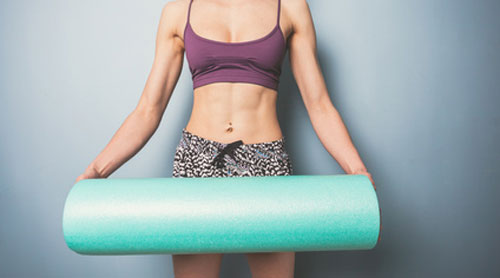 Self-Myofascial release, a fancy term for self-massage, is fast becoming a must-do for daily gym goers and professional athletes.
Self-Myofascial release, a fancy term for self-massage, is fast becoming a must-do for daily gym goers and professional athletes.
It’s the act of massaging the layer of soft tissue called the fascia, which covers the body’s connective tissue and can tighten due to repetitive motion. Runners especially, listen up!
Foam rolling 101
Most of us would have come across a strange firm foam tube in the gym or at the physio and not known what to do with it, so stayed away from it. Fitness experts and athletes are saying it’s time to embrace the foam roller, an essential tool for self-massage as they say it works wonders for the body.
Admittedly, it’s far from elegant as it involves rolling over a foam tube on the ground and no one would say it’s a pleasant feeling, but the after affects are well worth it.
Benefits of foam rolling
Few of us would object to having increased flexibility, and a recent study published in the Journal of Sport and Rehabilitation found foam rolling could aid bendiness. It was found that when athletes foam rolled their hamstring then stretched had an increased range in hip motion, compared to when they solely stretched prior to a workout.
Applying pressure to the muscle breaks up adhesion formed between the muscle layers and allows for the blood to flow and consequently muscles become more elastic and suitable for exercise. After a sweaty session it flushes out blood that has pooled in the working muscles and allows oxygen to flow through, which aids the recovery time of the muscles and mitigates muscle pain after an intense workout.
Going even further, connective tissue specialist Sue Hitzmann and creator of the MELT Method says foam rolling reduces the appearance of cellulite. Hitzmann says foam rolling exercises stimulate the cells in your connective tissue to restore its ‘juiciness’.
When should it be done?
In a perfect world, foam rolling would be done pre and post workout, but busy schedules often limits the time people can steal for the gym. If pushed for time, foam roll after a workout for a faster recovery.
How to do it?
You know your body, and what muscles need work or not. To foam roll correctly, apply moderate pressure to the specific muscles using your own body weight. Roll slowly over the muscle, no more than one inch per second until the whole muscle has been rolled.
The most important thing is, look after your body! If you have any abnormal or persistent pain contact your doctor.
Image / Fotolia – LoloStock

